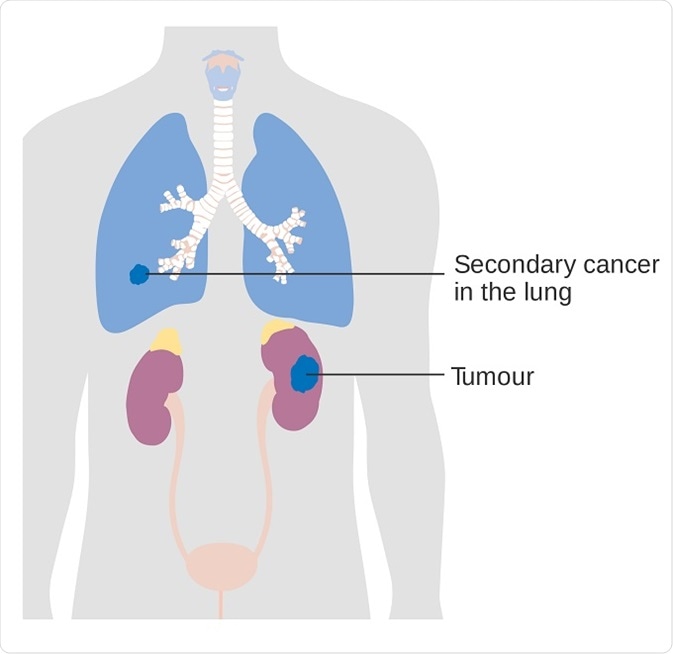In primary lung cancer, cancerous lung cells are the cause of cancer. The cell types in metastases or secondary cancer are the same as those in the primary cancer. For example, if the bowel cancer has spread to the lungs, then the cell type of the secondary lung cancer comprises of bowel cancer cells. In some patients, physicians are able to diagnose secondary cancer before diagnosing primary cancer. Depending upon the type of cancer, primary or secondary, physicians decide on the treatment type for the patients.

©Cancer Research UK uploader / commons.wikimedia.org
Symptoms & Diagnosis
Breast, kidney, bladder, bowel, bone, testicular and aggressive skin cancers are some of the cancers that may spread to the lungs.
General symptoms reported by patients of secondary lung cancer are:
- Fatigue
- Pain
- Loss of appetite
- Swallowing problems
- Weight loss
- Continuous infections in the chest
- Cough that seems to be permanent
- Coughing up blood
- Pleural effusion
- Shortness of breath
Tests, such as computerized tomography (CT) Scan, chest X-ray, bronchoscopy for viewing airways, lung needle biopsy, surgical lung biopsy, and cytological analysis of the pleural fluid, are used for the diagnosis of secondary lung cancer.
The first test to diagnose secondary lung cancer may be a chest x-ray. CT scans use radiation in small amounts and show a 3 dimensional view of the lungs. PET (positron emission tomography) scan may be carried out and this is done by injecting radioactive material into a vein before imaging is done.
Biopsy may be an uncomfortable test, where anesthetic is administered to the patient and samples are acquired by inserting a needle into the lung.
Treatments
Medicines are prescribed for controlling cough. Patients can also inhale the drug in the form of vapor. Physicians also suggest pain killers for alleviating cancer pain. They are consumed in the form of tablets, liquids, capsules, or in the form of injections or skin patches. Depending upon the relief that these medicines provide to the patients, physicians may adjust the dosage or provide other relevant drugs.
For patients with pleural effusion, the fluid that is built up between the lungs and the chest wall will prevent the lungs from expanding completely while breathing. This results in shortness of breath, discomfort, aches, and heaviness in the chest. Treatment such as pleurodesis is used by physicians to prevent the recurrent build-up of the fluid. A small amount of fluid is removed to check for cancer cells.
Depending upon the cause that creates shortness of breath, treatments such as oxygen therapy or laser treatment is recommended. Physicians also prescribe medicines (nebulizers) that can be breathed in by the patients for opening the airways. Stents—small tubes—will also be inserted if the air pathway is blocked by the cancer.
Treatments such as radiotherapy and Radiofrequency ablation (RFA) kill cancer cells. Radiotherapy also helps in reducing coughs. When the cancer blocks the air pathway, internal radiotherapy, such as endobronchial therapy or brachytherapy are used, which will reduce the size of the tumor block and help to breath easily; infection, if any, or bleeding that is caused by the tumor is also controlled, as the physician carries out the treatment inside the airway, near the tumor.
In general, surgery is not suited for other cancer types. However, for secondary lung cancer, the tumor is removed by surgery, provided the cancer has begun in the soft tissue sarcomas or bone. When the cancer has spread across to other places in the body, then surgery is not a possible option. By considering the location of secondary tumors in the lungs, their number and size, as well as expected performance of the lungs after surgery, and the health condition of the patient, the physician will opt to perform surgery. Before the operation or after completing the operation, patients may undergo biological therapy or chemotherapy.
Biological therapy, such as cancer growth blockers and monoclonal antibodies, is also suggested by physicians, which will prevent the growth of cancer cells.
Chemotherapy helps in controlling cancer growth and reducing disease symptoms.
The survival and growth of cancers, such as prostate cancer and breast cancer, are dependent on hormones. Hormone therapy in the form of injections or tablets can reduce the levels of hormone and control the growth of the cancer.
Though not all cancers are preventable, many type of cancers can be prevented when following a life style such as consuming healthy diet, having regular exercise, avoiding smoking and limiting consumption of alcohol.
The stress of the disease can be eased when patients join support forums where forum members exchange similar problems and experiences.
Sources:
- http://www.cancerresearchuk.org/about-cancer/secondary-cancer/secondary-lung-cancer/about
- http://www.macmillan.org.uk/information-and-support/lung-cancer-secondary#293223
- http://www.cancerresearchuk.org/about-cancer/secondary-cancer/secondary-lung-cancer/treatment
- https://www.cancer.ie/cancer-information/secondary-lung-cancer/symptoms-and-diagnosis#sthash.kPpliz6P.dpbs
- https://medlineplus.gov/ency/article/000097.htm
- www.bccancer.bc.ca/.../bone-secondary
Further Reading
Last Updated: Feb 26, 2019